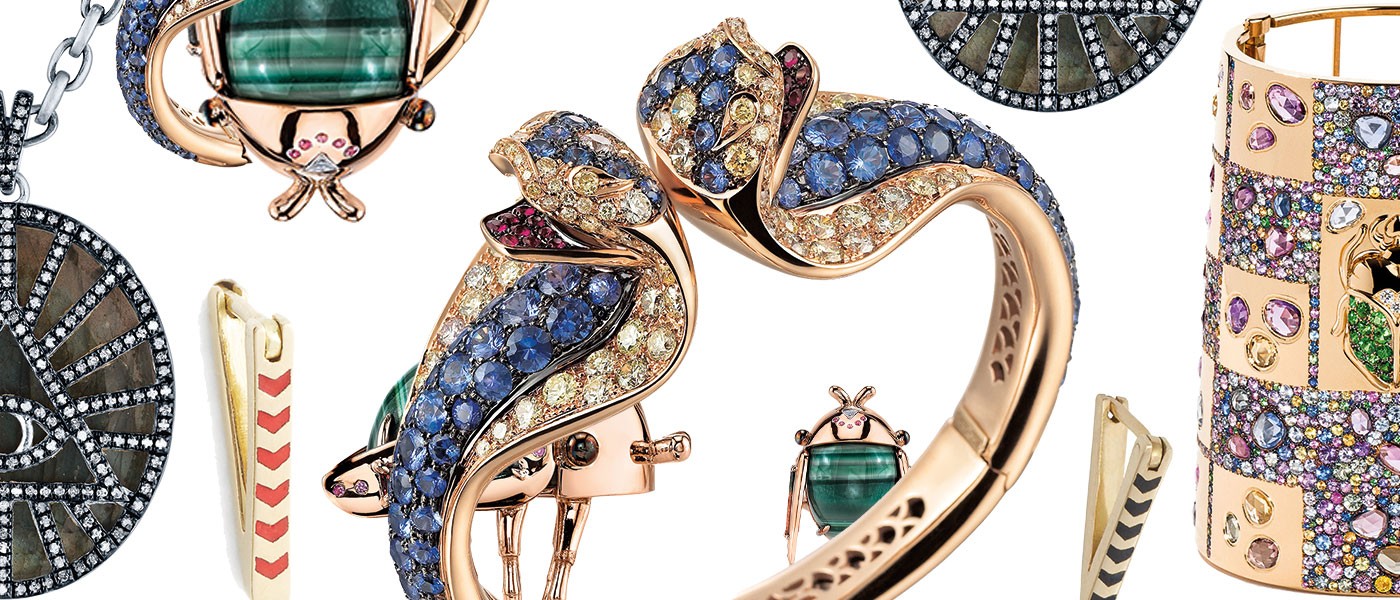
The New Egyptomania
The mystique of ancient Egypt inspires contemporary jewellery design.
The New Egyptomania
The mystique of ancient Egypt inspires contemporary jewellery design.
Ancient cultures, and Egypt in particular, fascinate both consumers and designers. They represent a time in history when all the knowledge of the world didn’t fit in your smartphone. The unknown left a large space for mystery. In the sparkling world of jewellery, symbolic design motifs such as the eye of Horus and Egyptian cobras carry this sense of magic into the 21st century.
Eye of Horus
The Eye of Horus symbolises protection, royal power and good health. This shape or symbol was often used for funerary amulets as it was intended to protect the pharaoh in the afterlife. It was originally called the Wedjat and is personified in the goddess Wadjet, who was associated with the land. The name Wadjet comes from ”wadj”, meaning ”the green one”. The ancient Egyptians believed that Wadjet was the patron and protector of Lower Egypt. Wadjet also protected kings and women in childbirth.

Earrings by Sylvie Corbelin
As its more common name depicts, the eye of Horus is also associated with the sky god Horus. Usually portrayed as a man with a falcon head, the symbol represents the marking around the eye of the falcon. One myth tells the story of how Horus and the war god Set were fighting for the throne after the death of Osiris. In the story, Set gouged out Horus’s left eye but it was later restored with the help of another deity. Horus then offered his left eye to his father Osiris in the hopes of restoring his life. Therefore, the eye of Horus also came to symbolise sacrifice and healing.
The eye is a popular motif within the world of jewellery. However, the eye of Horus includes the ”teardrop” shape that can be seen in the earrings above, created by Sylvie Corbelin.
Scarabs
The scarab, or more exactly the Scarabaeus sacer, was the symbol of the god Khepri. Khepri was a sun god, specifically connected to the rising sun, and was represented by the scarab because of its habit of rolling balls of dung across the ground. The ancient Egyptians saw this act as a symbol of the forces that move the sun across the sky. The scarabs also represent creation and rebirth as the beetles lay their eggs in the dung balls and their offspring emerge from them fully formed. Khepri is often portrayed as a scarab beetle but occasionally as a human male with a scarab as a head.

Cuff bracelet by Aurelie Bidermann. As seen in Trendbook 2018+
In contemporary jewellery, the scarab beetle is often depicted in yellow gold and gemstones as in these designs by Aurelie Bidermann and Daniela Villegas. In some versions they have wings, in other versions they don’t. As rings they usually cling to the wearer’s finger. Another popular silhouette is the necklace with a large, scarab medallion.

Rings by Daniela Villegas
The Egyptian Cobra
In Egyptian mythology, the Egyptian cobra was represented by the goddess Meretseger. She was portrayed as either a coiled cobra, a woman with a cobra head, or a three-headed cobra where one head was that of a woman, one of a cobra, and one of a vulture. She was a local deity closely associated to the Valley of the Kings. Meretseger protected the workers who built tombs, and would also spit venom at anyone who tried to vandalise or rob the royal tombs.
The Egyptian Cobra is also linked to the goddess Wadjet who was mentioned previously. A stylised version of the snake in the form of the uraeus (the cobra pictured in an upright form) represented her. It was a symbol of sovereignty and was incorporated into the diadems worn by pharaohs.

Bracelet by Paolo Piovan
Pyramids and Pyramidal Shapes
The pyramids are probably what most people think of when they hear the word ”Egypt”. The majority of the pyramids were built as tombs for pharaohs and thus they have a strong connection to the afterlife. Some even suggest that the pyramids were designed as ”resurrection machines”. The triangular shape of the pyramid itself probably represents the primordial mound from which the ancient Egyptians thought the world was created. It’s also believed to represent the descending rays of the sun, and most pyramids had a brilliant appearance through the use of reflective, white limestone.

Pendant by Jade Jagger. As seen in Trendbook 2018+.
Pyramid inspired jewellery comes in abstract styles -- where the focal point is the pyramid’s triangular shape -- as well as in more obvious versions. The bright colours that can be found in ancient Egyptian art are often reflected in the jewellery through the use of materials and stones like enamel, red coral, and blue or green turquoise.



